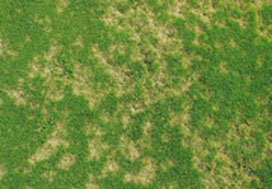Dollar Spot
Introduction
Dollar spot is a fungal disease that impacts upon both the visual appearance and surface quality of turf. It is of particular concern in situations where high surface quality is paramount e.g. creeping bent grass on golf courses. A broad range of turf species are potential hosts for this disease with susceptible species ranging from Bent grass (Agrostis) through to hybrid couches (Cynodon), Kikuyu (Pennisetum) and Zoysia spp.
Whilst we note here it is particularly prevalent on intensively managed turf, it is not limited to these situations. Home lawns, parks and other areas of amenity are also sites where this disease can be found. Dollar spot primarily affects leaf tissues but has been shown to have indirect effects on root structure and growth. The disease is found Australia wide.
Biology
The primary causal agent of dollar spot is Sclerotinia homeocarpa. The disease overwinters as sclerotia and as dormant mycelium from the lesions of previous infections. This then acts as the inoculum source for new infections. The onset of day time temperatures ranging between 15 to 27oc encourages mycelial activity with new infections occurring when moved by water and mechanical means.
Conditions favouring disease expression
The most conducive conditions for disease occur in spring and late summer / autumn however the problem can be present right throughout summer as well. Day time temperatures between 21 and 28 oc are optimal, with overnight conditions that produce dews enhancing the likelihood of infection. Relative humidity being high (>85%) significantly increases the likelihood of infection. Other factors implicated in disease prevalence are deficiencies of key macro elements nitrogen and potassium, excessive thatch accumulation, dry soils and poor irrigation practices.
Visual symptoms
On finer turf the ‘spots’ appear reasonably well defined in the early stages, 25-60mm in diameter, slightly sunken and tan in colour. Many spots may be found in close proximity to each other. On close inspection the lesions may become paler over time and cover the full width of leaf blades. On coarser grasses with larger leaf widths, the’ spot’ may be quite diffuse and poorly defined with close inspection revealing only part of the leaves being affected. A key feature is a constriction point or girdling (hourglass) often found on affected leaves.
Distribution
Found in all states of Australia, particularly coastal areas.
7. Pythium spp
Introduction
Pythium spp can potentially attack a wide range of turf grass species. This includes many of the widely used cool and warm season turf species utilised in sports turf and home lawns. There is considerable variation in susceptibility to these pathogens with perennial ryegrass (Lolium) and bent grass species (Agrostis spp) being particularly susceptible.
When different parts of the plant are attacked, different names are given to the condition caused. When foliage is affected the condition is sometimes termed ‘cottony blight’ or ‘grease spot’. When the crown and root areas are affected terms such as ‘Pythium crown rot’ or ‘Pythium root rot’ are used respectively.
When optimal environmental conditions prevail, infection can be rapid with significant resultant damage to above and below ground vegetative structures.
Biology
This fungus is classed as a water mold. It survives (overwinters) using a resilient spore structure (oospore). Once suitable conditions prevail, spore germination occurs and infection is perpetuated using mycelial growth which is the fine white webbing seen on moist morning conditions. The organism is very easily moved in surface water and by mechanical means (equipment and footwear).
Conditions favouring disease expression
The following conditions heighten the risk of Pythium infection.
- Daily minimum temperature above 17-20°c
- Daily maximum temperature exceeding 28°c
- Relative humidity exceeding 90% for more than 9 hours in the same period that conditions 1 and 2 are met.
Other factors that encourage infection are soil pH > 7.0, soft growth from high nitrogen fertilisers and poor draining soils.
Visual symptoms
Earliest signs are often small greasy irregularly shaped areas that are slimy to touch. When dry, these patches will have a straw coloured appearance and possibly a reddish tinge. These small spots may join together to form larger irregularly shaped areas and will often follow drainage lines.
Download PDF
